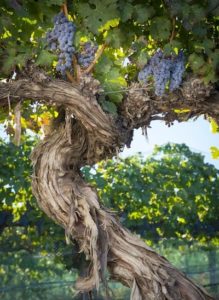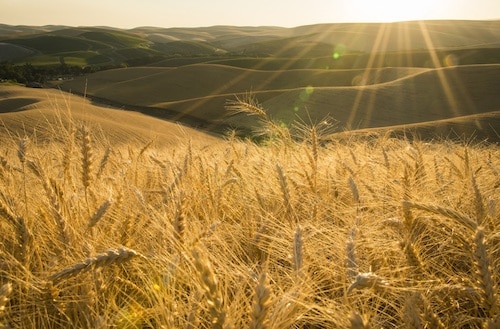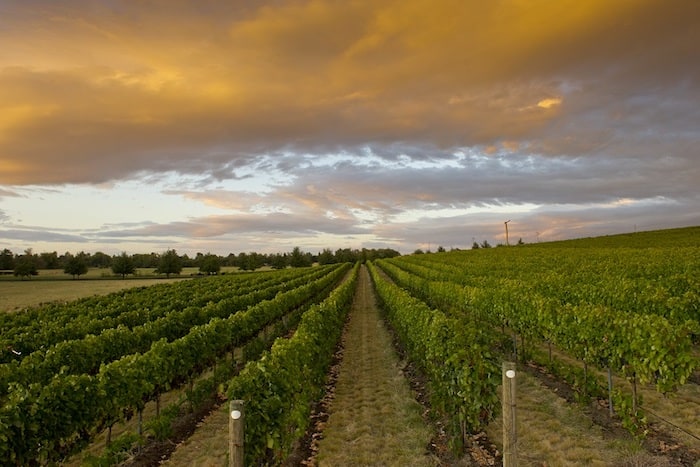Learn About the Columbia Valley Wine Region in Washington State
Last Updated on October 29, 2023.
Washington State’s Columbia Valley AVA is a breathtakingly beautiful region, located in the heart of the Pacific Northwest. It’s a place where you can immerse yourself in nature, soak up the sun, and discover some of the best wines in the world.
- Columbia Valley Wine Region Sub-Appellations
- Grape Varieties of Columbia Valley
- Columbia Valley's Food Scene
- The Columbia Valley Wine Region is a Winetraveler's Outdoor Paradise
- Where to Stay in Columbia Valley
- Discover the Story of Washington Wine
- Frequently Asked Questions about the Columbia Valley Wine Region
The Columbia Valley is situated in the eastern part of Washington State, bordered to the south by the Columbia River and to the north by the Okanogan River. The region covers an area of over 11 million acres, making it one of the largest wine-growing regions in the United States.
The climate of the Columbia Valley is what makes it such a perfect place for growing grapes. The region benefits from a dry, sunny climate, with warm days and cool nights. This unique climate allows the grapes to ripen slowly and develop complex, nuanced flavors. The topography of the Columbia Valley is also an important factor in the region’s wine production. The area is characterized by rolling hills, deep river gorges, and rugged mountain ranges. The soil here is diverse, conducive to growing a number of sought-after grape varieties, with a mix of sandy loam, volcanic rock, and mineral-rich clay.

Around 99% of all wine produced in Washington State comes from the Columbia Valley. In fact, the entire wine region extends beyond the borders of Washington to the South, encroaching on the northeastern portion of Oregon. If you’re looking to take a wine vacation to sample Washington’s production diversity, it’s safe to say that you need not go outside of this AVA.
Columbia Valley Wine Region Sub-Appellations
Currently, there are 10 sub-appellations with Columbia Valley, and more could potentially be announced.
The current list includes:
- Red Mountain
- Yakima Valley
- Walla Walla Valley
- Wahluke Slope
- Rattlesnake Hills
- Horse Heaven Hills
- Snipes Mountain
- Lake Chelan
- Naches Heights
- Ancient Lakes
The soil composition of these AVAs is varied. Many, many years ago, there were a series of floods that persisted throughout the region known as the Missoula Floods. During this time, a large amount of silt-based soil and sand was washed into the area, on top of the already existing volcanic rock and gravel. This soil makeup is ideal for growing grape vines, as it allows rainfall to drain much more efficiently.
RELATED: Discover 13 Amazing Wine Regions to Visit Around the World
At the same time, the continental-esque climate here is conducive to producing quality, concentrated and complex wine. Minimal rainfall (between 6-8 inches per year) occurs, forcing the vines to work a little bit harder to survive, thus yielding more concentrated fruit. While this is beneficial to an extent, such a small degree of precipitation often requires vintners to irrigate their vines. By controlling irrigation, producers can better control yields and fruit size, ensuring that vintages stay relatively consistent and of a higher quality.
Grape Varieties of Columbia Valley
This wine region is perhaps best known for its Cabernet Sauvignon and Merlot production, although fine expressions of Riesling, Chardonnay, and Syrah are also being produced. The current ratio of red to white is 58% to 42%.

Cabernet Sauvignon, the king of red wines and the most widely planted varietal in the region, is known for its bold flavors, with notes of black cherry, black currant, and a hint of vanilla. Tannins in these wines tend to be firm, providing a long, satisfying finish. Some of the key wineries producing Cabernet Sauvignon in Columbia Valley include Chateau Ste. Michelle, L’Ecole No. 41, and Woodward Canyon.
Next, we have Merlot. This varietal is a little softer and more approachable than Cabernet Sauvignon, with flavors of plum, blackberry, and a touch of chocolate. Merlot from Columbia Valley is known for its silky texture and smooth finish. Some of our favorite Merlot-focused wineries in the region include Columbia Crest, Hedges Family Estate, and Northstar.
For white wine, flavor and aromatic profiles largely depend on individual growing sites and microclimates. While most vines throughout the entire region are planted on South-facing slopes — which helps to capture the most sunlight during the growing season and promotes drainage during the winter — some vineyard sites are warmer than others.

Grape varieties such as Chardonnay and Riesling grown in cooler areas will almost always exhibit more citrus and tree fruit flavors (think lemon, lime, and melon).
On the other hand, warmer sites will typically yield more evidence of stone fruit in the wine (think peach, apricot, and nectarine). The use of oak varies and is dependent upon the individual producer, but Riesling tends to be unoaked, while Chardonnay could go either way.
While the above describes some of the more typical flavors and aromas of popular grape varieties, Columbia Valley’s vast landscape and diverse microclimates make it nearly impossible to generalize. Around 30 other grape varieties are also produced, ranging from Pinot Gris and Viognier to Cabernet Franc and Sangiovese. Don’t be afraid to sample some of the seemingly random grape varieties and blends. There are a number of innovative producers working to extract hidden gems from this relatively young AVA.
RELATED: Columbia River Gorge Itinerary: Travel Guide for Exploring the Region

Columbia Valley’s Food Scene
When it comes to the local food scene in the Columbia Valley wine region, there’s no shortage of delicious and diverse options to choose from. The region is known for its farm-to-table cuisine, highlighting the fresh produce, meats, and seafood that are sourced from the surrounding area.
When it comes to pairing food and wine from Columbia Valley, there are some classic combinations that are sure to please your palate. Here are a few of our favorites:
- Columbia Valley Cabernet with steak or grilled lamb: The bold tannins in Cabernet Sauvignon pair perfectly with the rich, savory flavors of grilled meats.
- Merlot with roasted chicken or pork: The soft, fruity flavors of Merlot complement the delicate flavors of roasted poultry and pork.
- Chardonnay with seafood or pasta: The buttery texture and tropical fruit notes of Chardonnay work well with rich seafood dishes like scallops or lobster, as well as creamy pasta dishes like fettuccine alfredo.
- Riesling with spicy Asian or Mexican dishes: The crisp acidity and subtle sweetness of Riesling help to balance the heat and spice of dishes like Pad Thai or tacos al pastor.
- Syrah with hearty stews or chili: The bold, smoky flavors of Syrah work well with hearty stews and chili, as well as other spicy dishes like Indian curries.
Of course, these are just a few examples of the many food and wine pairings that are possible in Columbia Valley. With so many delicious wines and fresh, local ingredients to choose from, the possibilities are truly endless. So why not plan a trip to the region and discover your own perfect food and wine pairing?
The Columbia Valley Wine Region is a Winetraveler’s Outdoor Paradise
If you love the great outdoors, then Columbia Valley is the perfect destination for you. The region is home to a wide range of outdoor activities, from hiking and biking to water sports and scenic drives. We love combining some of these activities with tastings throughout the day.
Hiking and Biking Trails
Columbia Valley is a paradise for hikers and bikers, with miles of trails winding through its beautiful landscapes. Whether you’re a seasoned hiker or a casual cyclist, there’s a trail for you. Some of the most popular hiking and biking trails in the region include the Apple Capital Loop Trail, the Klickitat Trail, and the Umatilla Rim Trail. These trails offer stunning views of the surrounding mountains, rivers, and vineyards, and are a great way to get some exercise while enjoying the great outdoors.
Water Activities
If you’re a fan of water sports, then Columbia Valley has plenty of options for you. The region is home to several rivers, lakes, and reservoirs, making it the perfect place for kayaking, paddleboarding, and fishing. Some of the most popular water activities in the area include kayaking on the Yakima River, paddleboarding on Lake Chelan, and fishing for salmon and trout in the Columbia River.
Scenic Drives
For those who prefer a more leisurely pace, Columbia Valley has plenty of scenic drives and tours to choose from. One of the most popular is the Columbia River Gorge Scenic Highway, which offers stunning views of the gorge and its waterfalls.
Where to Stay in Columbia Valley
When it comes to lodging options, Columbia Valley has something for every traveler, from luxurious hotels to cozy bed and breakfasts.
Some of the best lodging options in the area include Campbell’s Resort, a luxurious lakeside resort in Chelan, the Marcus Whitman Hotel, a historic hotel in downtown Walla Walla, and the Cameo Heights Mansion, a romantic bed and breakfast in Touchet. Another truly epic choice for luxury digs, views and especially for a wedding, is the Sagecliff Resort & Spa (formerly a part of Cave B. It overlooks the Columbia River Gorge (and is right next door to the legendary amphitheater). These properties offer a range of amenities, including on-site restaurants, spa services, and breathtaking views of the surrounding landscapes.
Accommodations for Different Budgets and Travel Styles
If you’re traveling on a budget, there are also plenty of affordable lodging options available in Columbia Valley. These include budget hotels, motels, and vacation rentals, as well as campgrounds and RV parks. One of our favorite budget-friendly lodging options in the area is the Lake Chelan Shores Resort.
Discover the Story of Washington Wine
Washington State is a majestically beautiful place. We encourage you to visit this magical region in the Pacific Northwest, and please feel free to ask us any questions in the comment section below.
Stay tuned over the next few months as we review a number of wineries worth visiting, in addition to recommended wine routes and trails to take throughout the Columbia Valley.
Frequently Asked Questions about the Columbia Valley Wine Region
You are reading “The Columbia Valley AVA Wine Region Guide” Back To Top
Washington State wine regions, Columbia Valley wine: Pacific Northwest road trips
If you enjoyed this guide, make sure you register to become a Winetraveler for free! You’ll get access to all of our content and interact with other Winetravelers and for travel inspiration around the world. Be sure to follow along with us on Instagram as we continue to feature more exciting destinations.